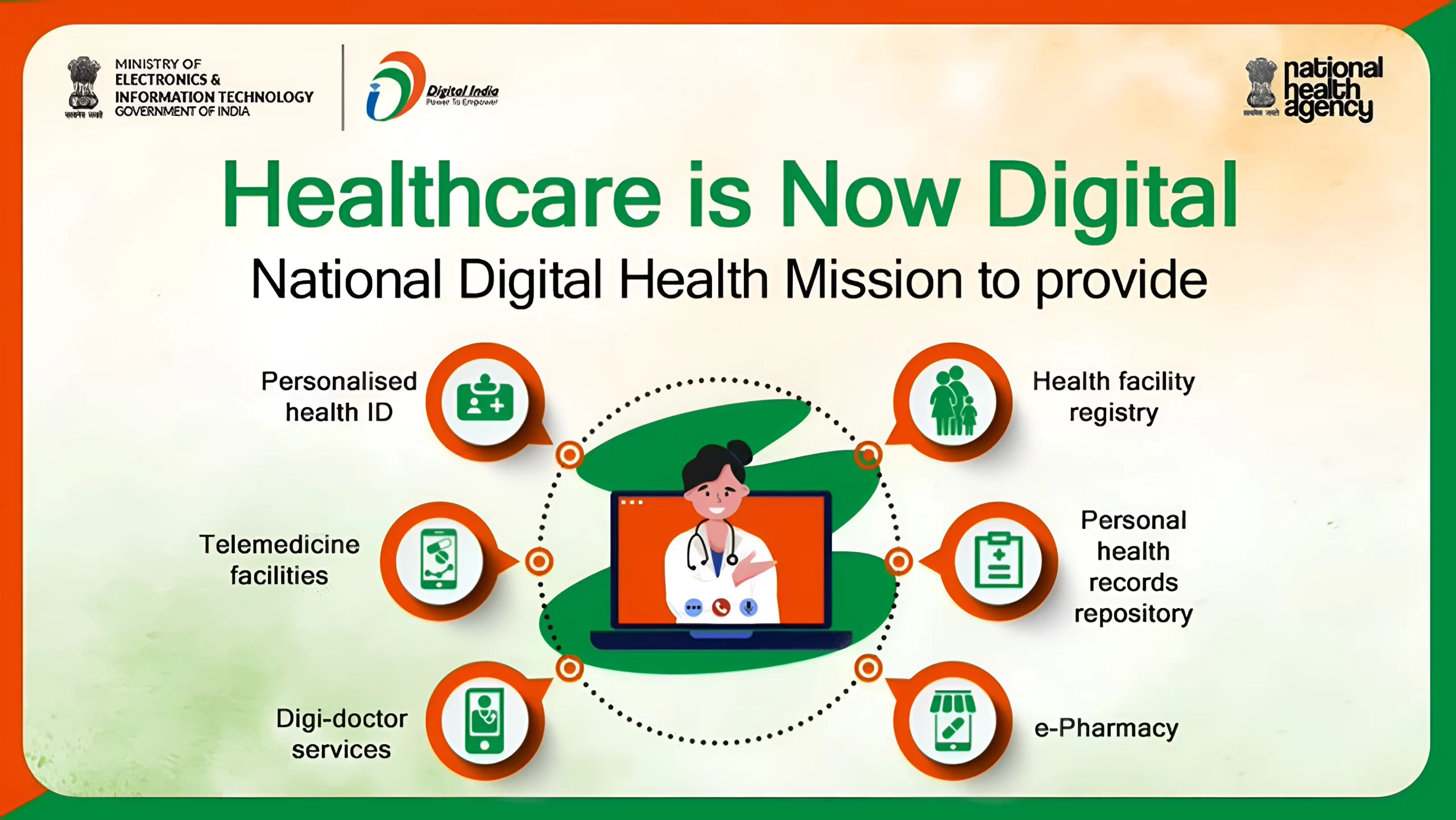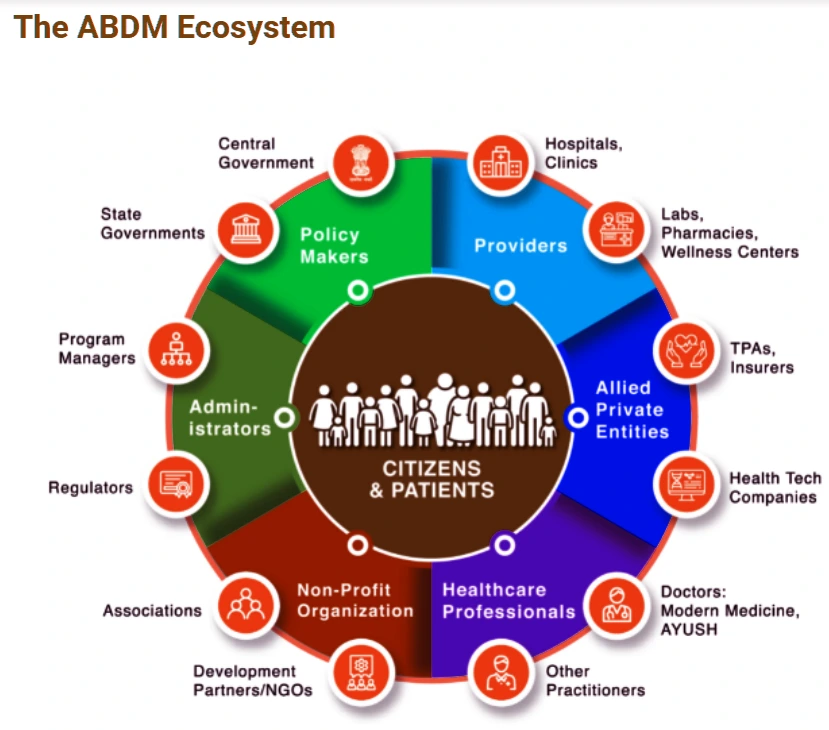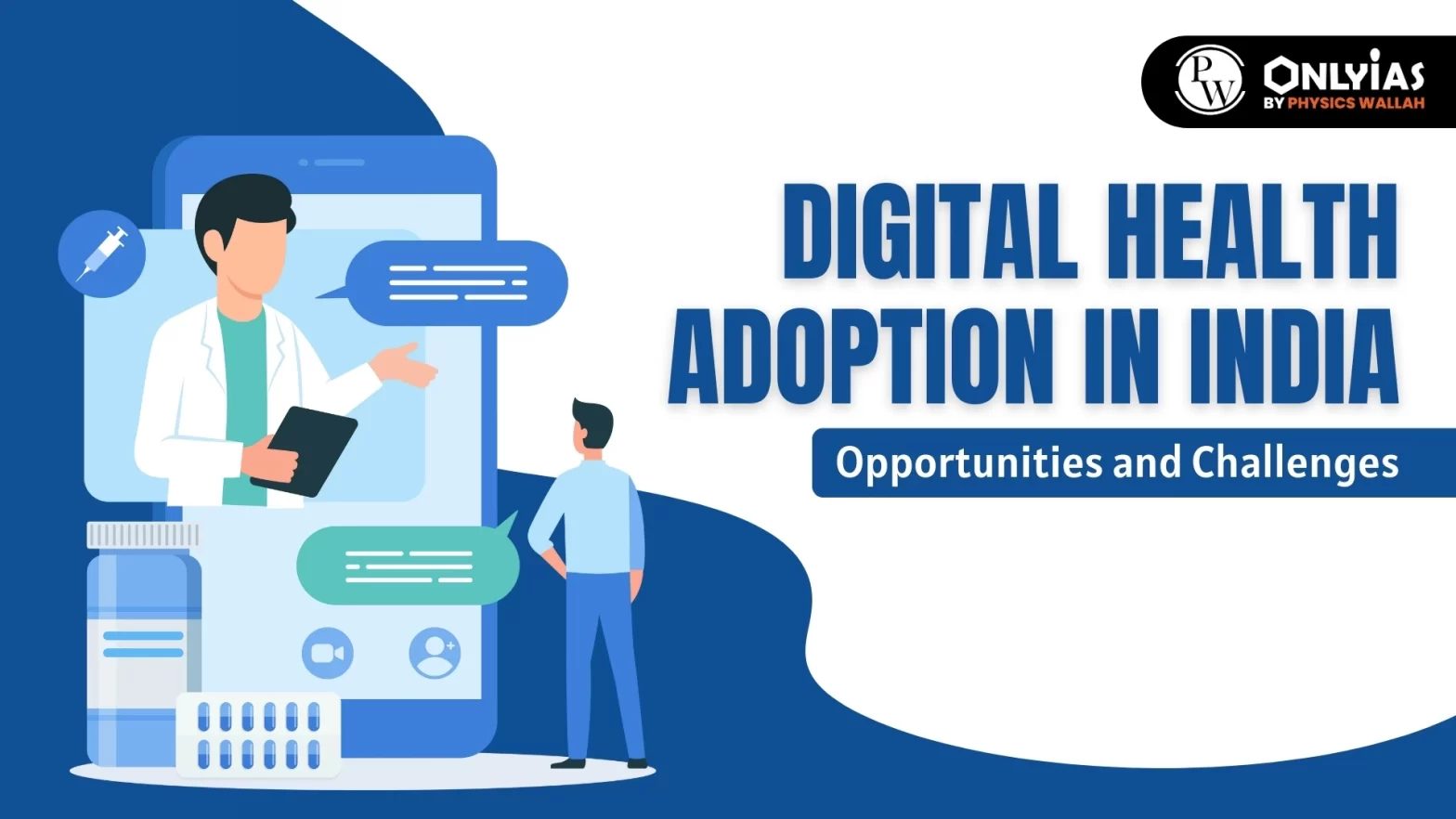Context: The COVID-19 pandemic has highlighted the importance of applying digital health technologies to strengthen health systems, prevent disease, and enhance service delivery.
Digital Healthcare Market in India
- It is estimated that the digital healthcare market in India will grow from $2.7 billion in 2022 to around $37 billion in 2030.
- As of August 2023, around 44.2 crore unique IDs have been created and 110 digital health services have been integrated into the digital mission.
State of Health in India
- Inadequate Health Infrastructure: The state of primary healthcare infrastructure varies greatly across India, with some states lagging.
- A recent report by the World Health Organization (WHO) highlighted that India has only 0.5 public hospital beds per 1000 population.
- India needs 3.5 million additional hospital beds to adequately serve the healthcare needs of the population.
- Shortage of Skilled Professional:
- As per National Health Workforce Accounts (NHWA) the stock density of doctors and nurses/midwives is 8.8 and 17.7, respectively, per 10,000 persons.
- All these estimates are well below the WHO threshold of 44.5 doctors, nurses, and midwives per 10,000 population.
- Epidemiological Transition: The rise of non-communicable diseases (NCDs) like cardiovascular diseases, cancers, and diabetes is a major concern, driven by unhealthy lifestyle choices.
- Obesity has increased from 19% to 23% between NFHS-4 and NFHS-5.
- According to WHO, Non-communicable diseases led to 66% of deaths in India in 2019.
- Low insurance coverage:
- Despite increased health insurance coverage, millions remain uninsured, and out-of-pocket expenses are high.
- The share of Out-of-Pocket Expenditure (OOPE) in total Health Expenditure (THE) declined from 62.6% to 47.1%, it is still high.
- Fragmented healthcare Market: Standalone hospitals and nursing homes provide 95 percent of private hospital beds.
- Though these institutions provide a much-needed service, they are unable to provide multi-specialty, let alone tertiary and quaternary care.
- The ethical and regulatory concerns:
- The ethical and regulatory concerns surrounding the use of AI in healthcare need urgent attention.
- AI and Robotics are increasingly being used in surgery, diagnosis, and medical decision-making.
What is Digital Health?
- Digital Health refers to the integration of technology, data, and electronic communication in healthcare.
- It encompasses a wide range of applications including health tracking, telemedicine, electronic health records wearable devices health apps, etc.
| Types of Digital Health
Digital Health is an umbrella term, which includes several types, as mentioned below:
- Electronic Medical Records (EMRs): Considered a digital version of medical records, EMRs contain vital data from a healthcare provider’s chart, such as medications, allergies, background, any diagnosis, etc.
- Telemedicine: Telemedicine refers to the practice of providing care to patients over the phone or via video call.
- Mobile Health/mHealth: Similar to telemedicine, mHealth refers to the use of mobile to access healthcare services.
- E-Prescribing: As the name suggests, this method involves electronically creating a prescription and delivering it to the patient or pharmacy.
|
Digital Health as Catalyst to Universal Health Coverage (UHC)
- Universal Health Coverage, a core objective of Sustainable Development Goal 3, envisions providing essential health services to all individuals and communities without financial hardship.
Universal health coverage (UHC)
- According to WHO, Universal health coverage (UHC) means that all people have access to the full range of quality health services they need, when and where they need them, without financial hardship.
- It covers the full continuum of essential health services, from health promotion to prevention, treatment, rehabilitation, and palliative care across the life course.
|
- Digital health is a great enabler in the delivery of healthcare services and has the potential to support overall universal health coverage targets.
- India has adopted a two-pronged approach
- Focusing on digital health through policy framework and
- Creating a digital ecosystem for path-breaking interventions that focus on not just availability, accessibility, and affordability but also equity of health services.

Ayushman Bharat Digital Mission (ABDM): Components
- ABDM aims to develop the backbone for the country’s integrated digital health infrastructure.
- Components Of ABDB:
- ABHA Number: The ABHA number will be used to uniquely identify persons, authenticate them, and thread their health records (only with the informed consent of the patient) across multiple systems and stakeholders.

-
- ABHA Mobile App (PHR):
- A PHR is an electronic record of health-related information on an individual that conforms to nationally recognized interoperability standards and that can be drawn from multiple sources while being managed, shared, and controlled by the individual.
- The most salient feature of the PHR, and the one that distinguishes it from the EMR and EHR, is that the information it contains is under the control of the individual.
- Key features of the ABHA mobile application are:
- Creation of ABHA Address
- Discovery of Health Information
- Linking of health records/ with a given ABHA Address
- View Health Records
- Management of consents
- Healthcare Professionals Registry (HPR):
- It is a comprehensive repository of all healthcare professionals involved in delivery of healthcare services across both modern and traditional systems of medicine.
- Health Facility Registry (HFR)
- It is a comprehensive repository of health facilities of the nation across different systems of medicine.
- It includes both public and private health facilities including hospitals, clinics, diagnostic laboratories and imaging centers, pharmacies, etc.
Must Read: Renaming of Ayushman Bharat Health and Wellness Centres
Digital Health: Benefits
- Build a Comprehensive Health Ecosystem: Emerging technologies such as Artificial intelligence, the Internet of Things (IoT), Blockchain, and Cloud Computing provide additional opportunities for facilitating a more holistic digital health ecosystem that can increase equitable access to health services, improve health outcomes and reduce costs.
- For instance, in 2021 in the USA, AI-assisted CT imaging was used to detect pneumonia and treat COVID-19 patients.
- Bridge Gap Between Urban- Rural Healthcare: Digital health technologies can help to bridge the gap between urban and rural healthcare by bringing medical expertise to remote locations.
- For example, Telemedicine, allows patients to see their doctor via video call, eliminating travel and reducing wait times.
- Streamline healthcare processes: Additionally, digital healthcare solutions streamline them, making them more efficient and cost-effective.
- For Example, Electronic health records (EHRs) enable a seamless exchange of patient information between healthcare providers, ensuring continuity of care and reducing medication errors.
- Improve Healthcare Providers’ productivity: New AI models fundamentally enhance a doctor’s productivity, enabling a doctor to attend to many more patients with a higher quality and better productivity.
- For example, generative AI can help enhance the productivity of clinicians with note-taking and content summarization that can help keep medical records as thorough as possible.
- AI could also help with accurate coding and sharing of information between departments and billing.
- Health Management System: The digitization of healthcare systems creates vast amounts of data that can be analyzed to gain valuable insight into disease patterns, treatment outcomes, and population health trends.
- Insights from these data can potentially transform health policy, resource allocation, and public health interventions.
- Innovative partnerships and consolidation: The Indian digital health ecosystem offers healthcare startups and established players opportunities to scale their services and thrive.
- Startups and established players collaborate to leverage their strengths and maximize value. Examples include pharma companies partnering with disease-management platforms and insurance companies partnering with health-tech players.
- The fragmented healthcare market is seeing consolidation, particularly by large players like Tata, Reliance, PharmEasy, etc.
Digital Health Adoption in India: Challenges
- Lack of Infrastructure:
- Limited digital infrastructure: This includes unreliable internet connectivity, lack of access to devices, and poor digital literacy, particularly in rural areas.
- Digital literacy and digital divide: Many citizens, especially in rural areas and among older generations, lack the basic digital skills needed to access and utilize digital health platforms.
- Privacy concerns:
- Data privacy: There is a lack of trust in how data is collected, stored, and used by healthcare providers and tech companies.
- Security breaches: Concerns exist about the potential for data leaks and misuse of sensitive health information.
- For Example: In November 2022, AIIMS faced a cyber–attack. As the servers went down, it affected the out-patient department (OPD) functioning and also sample collection services.
- Lack of standardization and interoperability:
- Inconsistent data formats and standards: This makes it difficult for different healthcare systems to communicate and share information seamlessly.
- Fragmented ecosystem: The lack of a unified platform or standard protocols creates inefficiencies and hinders data exchange.
- Regulatory framework:
- Rapidly evolving technologies: Regulatory frameworks often struggle to keep pace with the rapid advancements in digital health technologies.Uncertainty and ambiguity: The absence of clear regulations and guidelines creates uncertainty for stakeholders, leading to hesitancy in adopting and implementing digital solutions.
- Data governance and compliance: The lack of robust data governance and compliance mechanisms can increase the risk of data breaches and misuse of information.
- Additional challenges:
- Lack of skilled professionals: There is a shortage of healthcare professionals trained in using and managing digital health technologies.
- Cost and affordability: developing and implementing digital health solutions can be a significant cost, particularly for smaller healthcare providers.
| Digital Health Initiatives by Center
Co-Win: It is an open platform for the management of registration, appointment scheduling & managing vaccination certificates for COVID-19. It has registered 110 crore persons and has facilitated the administration of 220 crore doses of vaccinations.
Aarogya Setu: Aarogya Setu is a mobile application developed to connect essential health services with the people of India in our combined fight against COVID-19.
e-Sanjeevani: first-of-its-kind telemedicine initiative by any country has two variants:
- eSanjeevani Ayushman Bharat-Health and Wellness Centre (AB-HWC): A Doctor-to-Doctor telemedicine service under Ayushman Bharat-Health and Wellness Centres scheme, to provide general and specialised health services in rural areas and isolated communities.
- eSanjeevaniOPD: This is a patient-to-doctor telemedicine service to enable people to get outpatient services in the confines of their homes.
Digital Health Incentives Scheme (DHIS): as part of the Ayushman Bharat Digital Mission
Under the DHIS, the eligible health facilities and digital solutions companies shall be able to earn financial incentives of up to Rs. 4 crores based on the number of digital health records created and linked to ABHA (Ayushman Bharat Health Account) numbers of the patients. |
Global Initiative for Digital Health (GIDH): India in collaboration with the World Health Organization (WHO) will launch the Global Initiative on Digital Health.
- Aim: The first-of-its-kind global initiative is aimed at data convergence, the interface of health platforms, and investments in the digital health space around the globe.
Significance of Global Initiative for Digital Health (GIDH)
- It has been envisaged to have a convergent approach that breaks the silos and ensures that existing and ongoing digital health efforts can be made accessible under one umbrella.
- It will include an investment tracker, an ask tracker (to understand who needs what kind of products and services), and a library of existing digital health platforms.
- It will aid in universal health convergence and improve healthcare service delivery. The initiative has also found funding from global partners.
|
Way Forward: Digital Healthcare Towards Universal Health Coverage in India
- Bridging the Digital Divide: Infrastructure expansion: Investing in reliable internet connectivity, affordable devices, and digital literacy programs, particularly in rural areas and among vulnerable populations.
- Local language support: Localizing digital health platforms and resources to ensure accessibility and inclusivity.
- Developing user-friendly interfaces: Designing digital health platforms that are easy to use and accessible to people with varying levels of digital literacy.
- Strengthening the Regulatory Framework:
- Developing clear and comprehensive regulations: Establishing data privacy standards, security protocols, and guidelines for data collection, storage, and sharing.
- Promoting interoperability: Implementing standardized data formats and interoperability protocols to enable seamless data exchange between different healthcare systems.
- Creating a robust regulatory body: Establishing a central authority responsible for overseeing the digital health ecosystem, ensuring compliance with regulations, and addressing emerging challenges.
- Comprehensive Digital Health Ecosystem:
- Established players: Established players need to integrate digital capabilities into their existing business models and adopt a “startup mindset.”
- Startups: Startups need to find a product-market fit, identify a value pool, and define the scope of their services. Partnering with other players in the ecosystem can enhance their success.
- Fostering Innovation and Collaboration:
-
- Promoting public-private partnerships: Encouraging collaboration between government, healthcare providers, technology companies, and research institutions to accelerate innovation and develop effective digital health solutions.
- Supporting startups and entrepreneurs: Providing funding, mentorship, and infrastructure support to startups developing innovative digital health technologies.
- Leveraging existing platforms: Integrating digital health solutions with existing healthcare infrastructure, such as public health facilities and community health centers.
- Building Capacity and Expertise:
-
- Investing in training programs: Equipping healthcare professionals with the necessary skills and knowledge to use and manage digital health technologies effectively.
- Encouraging knowledge sharing and collaboration: Fostering a culture of knowledge sharing and collaboration among stakeholders in the digital health ecosystem.
- Prioritizing Patient-Centricity:
-
- Ensuring patient privacy and security: Implementing robust data protection measures and empowering patients to control their health data.
- Focusing on affordability: Developing cost-effective digital health solutions that are accessible to all sections of society.
- Monitoring and Evaluation:
-
- Collecting data and tracking progress: Regularly monitoring the impact of digital health interventions and using data to inform decision-making and adapt strategies.
- Conducting research and evaluation: Investing in research to evaluate the effectiveness and efficiency of digital health interventions and identify areas for improvement.
- Promoting transparency and accountability: Publicly available information about digital health initiatives, data usage, and performance metrics.
Conclusion:
India stands at the cusp, well positioned to create the new age models of healthcare for India and the world to adopt.
| Prelims Question (2022)
With reference to Ayushman Bharat Digital Mission, consider the following statements:
1. Private and public hospitals must adopt it.
2. As it aims to achieve universal health coverage, every citizen of India should be part of it ultimately.
3. It has seamless portability across the country.
Which of the statements given above is/are correct?
(a) 1 and 2 only
(b) 3 only
(c) 1 and 3 only
(d) 1, 2 and 3
Ans: (b) |
| Mains Question (2020): The COVID-19 pandemic has caused unprecedented devastation worldwide. However, technological advancements are being availed readily to win over the crisis. Give an account of how technology was sought to aid the management of the pandemic. |
![]() 11 Dec 2023
11 Dec 2023


